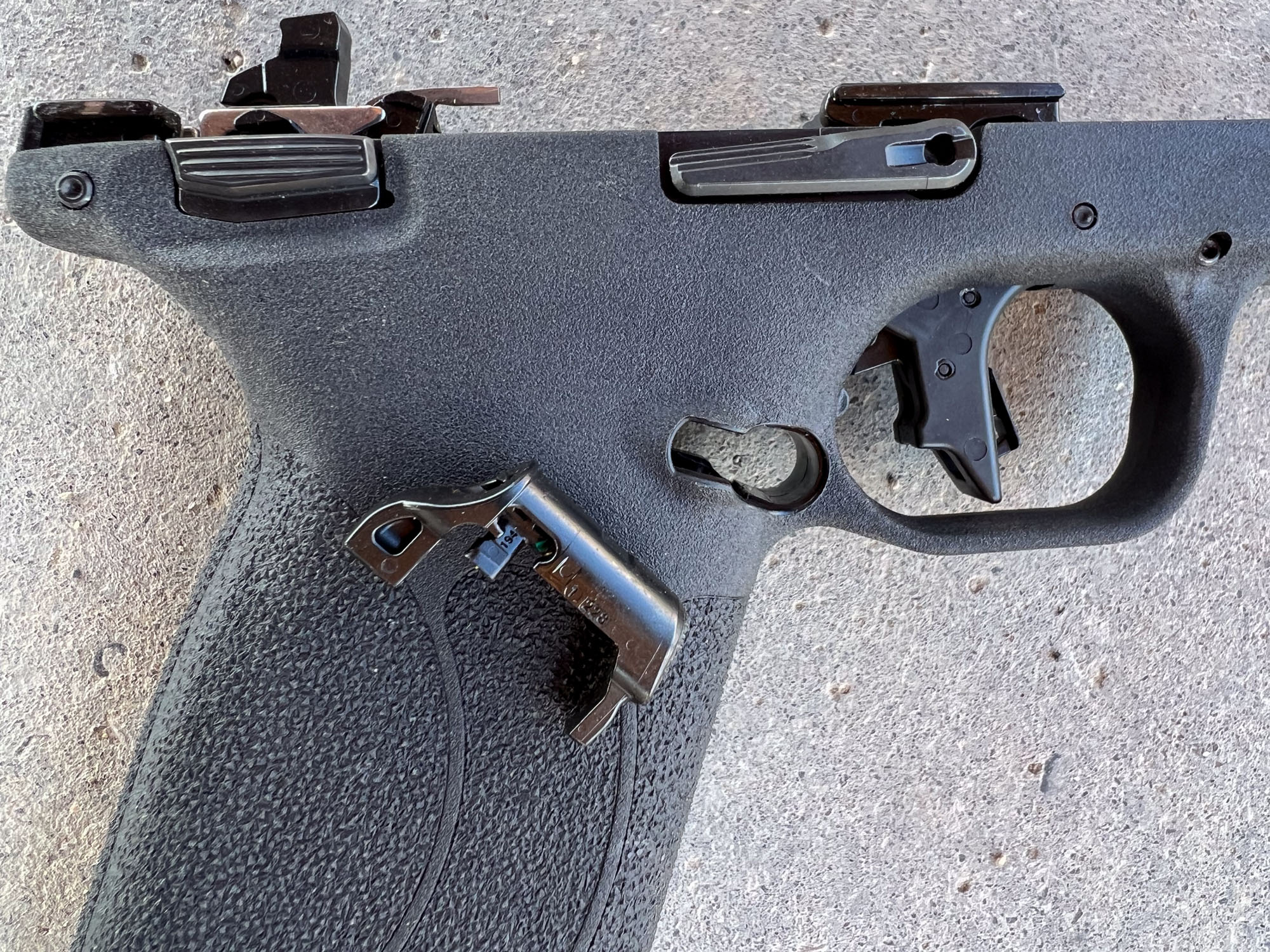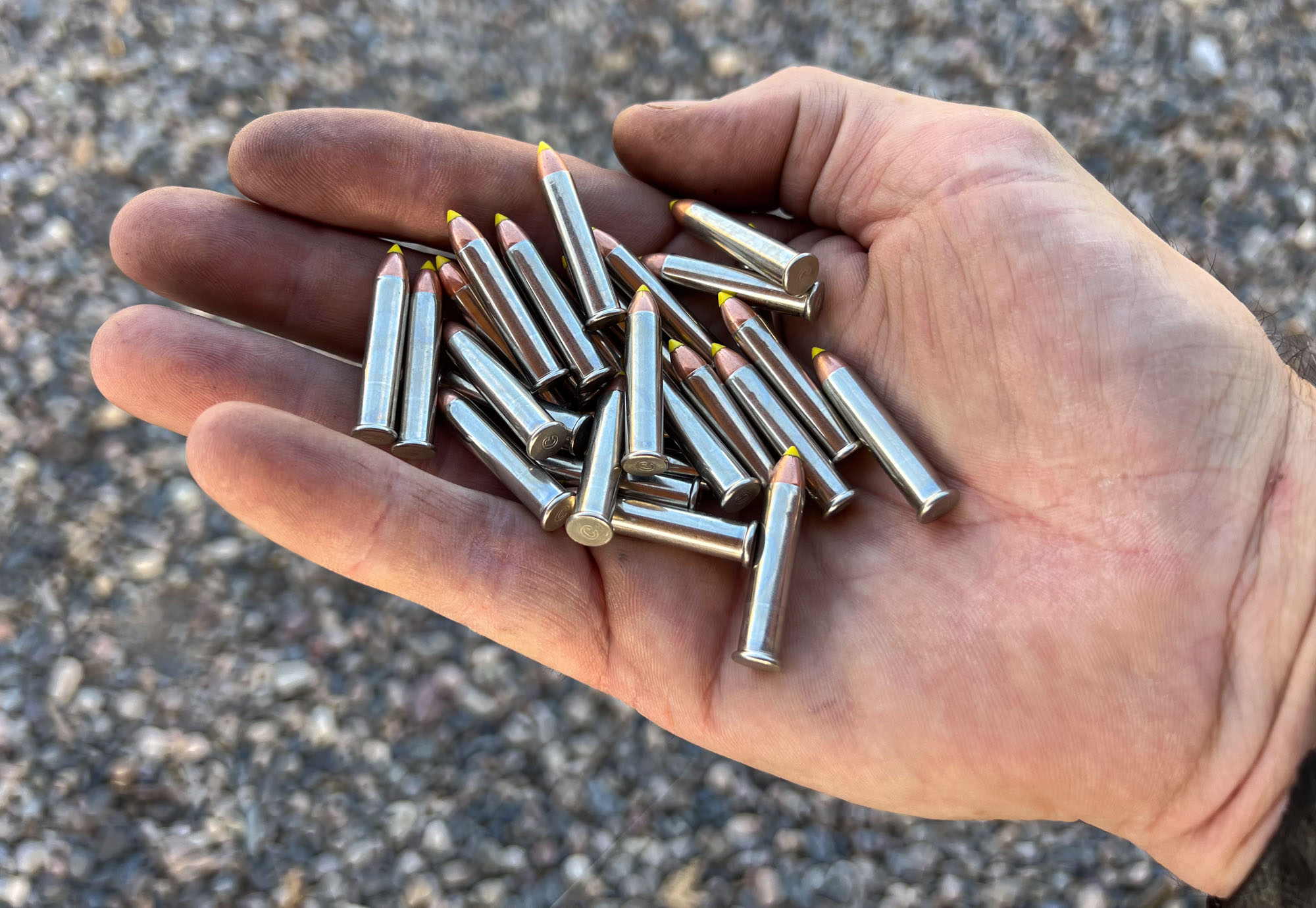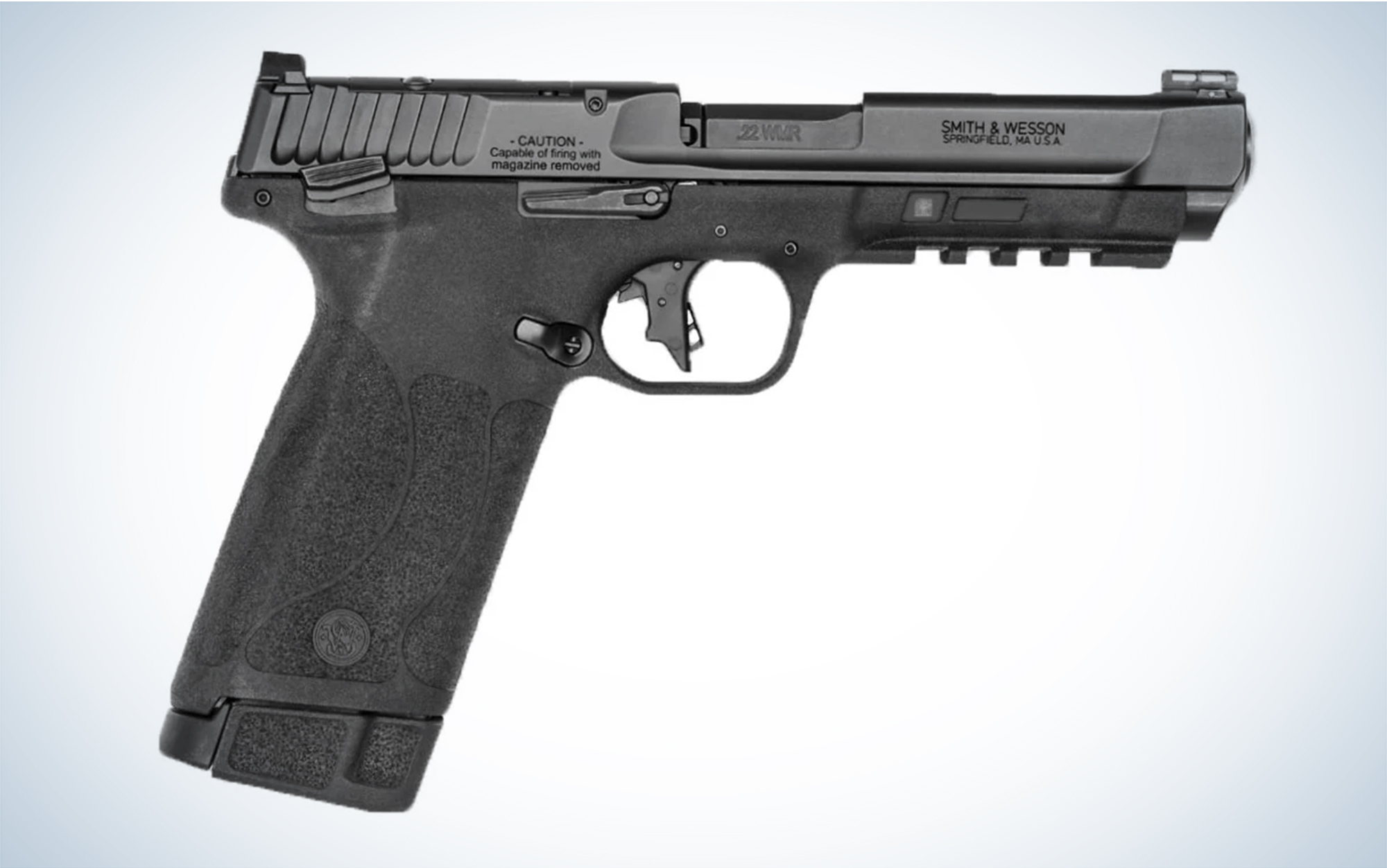We may earn revenue from the products available on this page and participate in affiliate programs. Learn More ›
I knew from the moment I heard about the Smith & Wesson M&P 22 Magnum that I was going to enjoy shooting the pistol. What I didn’t realize was the danger it posed to my ammunition budget and supply.
The M&P 22 Magnum is the newest rimfire from S&W and is, without question, one of the most entertaining guns I’ve shot this year. Chambered in .22 WMR, the pistol holds 30 rounds in each of its two magazines.
That’s an impressive fusillade to have on tap in a portable package. Though the frame dimensions put it in the full-sized category, it is light enough (1 pounds, 6 ounces) to comfortably carry on your hip or in a ruck sack.
As a trail gun it is one of the top available options. Woe unto the rattlesnake, cottontail, or spruce grouse that ends up looking down its barrel. Based on its capacity alone, and some of the more stout projectiles to be had in the Winchester Magnum Rimfire cartridge, it is no slouch in the personal protection department either.
In fact, the M&P 22 Magnum, like other firearms chambered in .22 WMR, is quite versatile thanks to the broad range of bullets loaded for that cartridge. This includes Winchester’s 25-grain NTX polymer-tipped bullet at the lighter end of the spectrum, and Federal’s 50-grain JHP bullet on the other, with the most common bullet weight being 40-grains.
- Caliber: .22 WMR
- Capacity: 30+1
- Action: Semiauto, internal hammer fired
- Barrel: 4.4-inch, bull profile, stainless steel
- Dimensions: 8.25 inches long x 5.5 inches high x 1.125 inches wide
- Weight: 22 ounces (with empty 17-round magazine, measured)
- Frame: Polymer
- Slide: Stainless steel with Armornite black nitride finish
- Optics: Accepts Shield RMSc footprint optics
- Controls: Ambidextrous safety and slide stop, reversable magazine catch
- Finish: Black
- Grip: Polymer grip module, laser-etched stipple texture
- Sights: Fixed with fiber-optic front post, rear is drift adjustable
- Trigger: 3 pounds, 10 ounces (measured)
Smith & Wesson M&P 22 Magnum Walkthrough
Before taking a deeper look at the pistol’s utility, let’s first consider its design. Externally, the pistol isn’t very surprising, which I mean as a compliment. It exhibits many of the best features that have become standard on today’s semiauto handguns.
Polymer Frame
The frame on the M&P 22 Magnum is molded polymer that’s executed quite well. It includes a substantial accessory rail on the dust cover with four cross slots for mounting a light or laser.
Ergonomically, Smith & Wesson did an excellent job with the frame. The rear of the trigger guard is relieved, and coupled with the frame’s deep beavertail the shooter is able to get a high and solid grip on the gun.
The entire frame has a sandpaper-like texture that’s functional and comfortable. The grip itself has a texture that’s like 120-grit, while the rest of the frame sports something akin to an 800-grit finish. It provides a solid connection to the gun, even when wet, but isn’t sharp or jarring so even the most tender-handed shooter won’t find cause to complain.

Ambidextrous Controls
The Smith & Wesson M&P 22 Magnum is lefty friendly. It has ambidextrous controls for the safety and slide release that are easy to reach and manipulate with either hand. That said, the low-profile, snag-free safety is a bit easier to move into the “safe” position with the right hand than the left. But taking the gun off safe is smooth and simple from both sides, which is what really counts.
The magazine catch can be swapped from one side to the next with nothing more than a narrow slot-head bit. The screw head in the mag catch assembly needs to be rotated just 90 degrees and the whole thing slides out. Just install it on the other side and turn the screw head to lock it in place and you’re done.
Iron Sights
The iron sights on the S&W M&P 22 Magnum consist of a fiber optic dot in a square post up front and a square-notched rear that adjusts for windage. My sample would have benefited from a touch of elevation adjustment, as the point of impact was a hair lower than I prefer.
A typical 6 o’clock-hold, where the front sight sits just underneath the intended point of impact didn’t work with mine. I needed to place the bright green dot on the front sight over my target, and then give it just a touch more on top of that.
This didn’t diminish my experience with the pistol in any meaningful way—I was still able to get accurate hits with it at long distances—but it does require the shooter to adapt to the gun rather than vice versa.

Optics Ready
Fortunately, the Smith comes optics compatible, so you can forgo the irons. The slide has a plate held in place by two 5/64th Allen screws and when removed the plate exposes the Shield RMSc pattern mounting holes. (Removing the plate also exposes the firing pin mechanism and the internal block which is a safety that prevents the hammer from hitting the firing pin unless the trigger is held all the way to the rear.)
While I am a big fan of reflex sights—check out my in-depth review of the best red-dot sights if you’re in the market—I opted to do all my shooting with the pistol’s fixed irons.
Smith & Wesson M&P 22 Magnum’s Trigger
The trigger has a tab-safety in the center of the trigger shoe. When depressed it lets you take up the trigger’s 3/8-inch of slack. My pistol’s trigger weight measured 3 pounds, 10 ounces, with a consistent crisp break with little discernible creep. The reset is sharp as well, giving good tactile feedback.
Fit and Finish
Smith finished the stainless steel slide in their durable Armornite black nitride. I’m very familiar with it, and can vouch for its durability and toughness. The polymer frame is likewise built for hard use and should provide years of service.
The fit on the pistol is good, but is a notch below the M&P 2.0 for instance. The 22 Magnum has a pronounced gap between the slide and frame allowing for dust and debris to enter the works. The pistol also has a noticeable gap where the magazine and frame meet.
The Smith & Wesson M&P 22 Magnum’s Interesting Action
From the outside the 22 Magnum might look like a striker-fired pistol, but that’s not the case. It has an internal hammer that does the work of striking the firing pin. An even more significant departure from the striker-fired cookie-cutter template that characterizes so many semis is the gas operating system it employs.
Understanding Blow-Back Design
Most pistols operate on a blow-back design, where the mass of the slide assembly is used to counter the mass of the bullet. The heavier slide moves backward at a relatively sluggish pace, allowing the speedy bullet to exit the barrel before it has traveled rearward any significant amount. Once the bullet is clear of the barrel, the pressure gases generated by the ignition of the cartridge escape out of the muzzle (following the path of least resistance).
This system ensures that the brass case is supported enough by the chamber and breech so that it doesn’t rupture and otherwise direct potentially harmful pressurized gas toward the shooter. Though it earns high marks for simplicity and reliability, this system also necessitates that the slide be heavy enough to counteract the pressures generated by the cartridge.

S&W M&P 22 Magnum Gas Piston
The 22 Magnum takes a different approach. The barrel contains two pieces: an exterior sleeve and the actual barrel that sits on the inside of it. The barrel has a gas port near the muzzle and a series of gas checks along its length.
Once the bullet passes the port, gasses flow into the space between the barrel and sleeve which push against the checks, forcing the barrel rearward helping to cycle the action.
Smith & Wesson calls this their TEMPO barrel system, which they also employ on the M&P 5.7. The 5.7×28, like the .22 WMR, is a relatively high-powered pistol round, so running a modified action that delays the rearward travel of the barrel until the chamber pressures have dropped a bit makes sense. With this gas-operated action, the barrel doesn’t cam open until the bullet has passed the gas port.
This also allows for a lighter slide, which explains in part the 22 Magnum’s light, portable weight.

Smith & Wesson M&P 22 Magnum Takedown and Maintenance
This gas system requires the shooter to keep track of the number of rounds put down the barrel. Smith & Wesson recommends cleaning at least every 500 rounds.
One drawback to the pistol is that the takedown procedure is a bit cumbersome. To remove the slide from the frame one must move the slide rearward about a quarter of an inch and then use a punch to drift the slide stop out of the frame. It isn’t difficult to do but compared to the majority of pistols out there that have tool-less takedown systems it is more complicated.
Once the slide is off it is easy to remove the barrel and barrel-shroud assembly to clean out whatever gunk has accumulated. The pistol has a captured recoil spring so that’s simple to handle.
With the slide off the frame, it is easy to access and clean the rest of the works too. Smith recommends keeping the frame rails lubed us, as well as the piece on the trigger mechanism that bears against the plunger on the internal safety block.
Smith & Wesson M&P 22 Magnum at the Range
I quickly hit—and surpassed—the 500-round threshold my first day at the range with pistol, and it kept ticking the whole time, though I did experience a handful of stoppages and failures to feed.
Overall, the pistol is absurdly fun to shoot. The bad news is you’re going to pay for the privilege. Twenty-two WMR ammo typically costs $.30 to $.40 per round, which translates to $15 to $20 per box of 50 or—more to the point—10 to 12 bucks per fully loaded 30-round magazine.
I lost count of how many mags I put through the pistol. I meant to keep meticulous notes of the round count, but once I got the gun running, I got caught up in the moment. Judging by the sparkling layer of empties I left at my gun range, it was a pile.

Smith & Wesson M&P 22 Magnum Accuracy
I started by shooting the pistol for accuracy at 7 yards. I had five different .22 WMR loads to test and did a series of 10-shot groups with each. Here’s what I shot:
All the rounds grouped well, and it was during this part of the evaluation that I learned that POI was a touch low with the fixed sights. I shot these strings rapidly to get a feel for the pistol’s trigger, recoil impulse, and general ergonomics.

John B. Snow
On average, the 10-shot groups ranged from 1.5 to 2.25 inches, which was plenty good in my book given that I wasn’t shooting off a supported rest.
I moved back to 25 yards and shot more deliberately at the head of an MGM BC-C Zone IPSC target. I had no trouble holding hand-sized groups at that distance.
Going back to 50 yards, the pistol still performed well. It turned in 10-shot groups that measured 6 inches, which is pretty good for offhand shooting with iron sights.
In terms of its work as a trail gun, it is minute-of-mouse at 7 yards, minute-of-grouse at 25 yards, and minute-of-coyote/jackrabbit at 50 yards. I have no doubt that with a red-dot installed it would be even more effective at all distances.

Working a Spinner
One of the ideas behind a pistol like the M&P 22 Magnum is that while each individual round might not be that impressive the fact that you have 30 of them at your disposal makes up for it.
To test that notion, I decided to see how the Smith would handle a full-sized spinning target. For those without first-hand experience shooting a spinner, it is one on of the best training tools for handgunning and even shotgun and rifle practice.
The basic idea is that you have to impart enough energy to the target with accurate hits in order to get it moving and then flip it over. It’s easy to describe and understand but can be devilishly difficult to make happen at the range.
Calculating the Broadside
Even with a 9mm handgun it is a challenge, and one way to help the cause is to use heavier 147-grain bullets. With the .22 WMR you don’t have any bullets that come close to that weight, so what you lack in potential energy and momentum with an individual projectile has to made up with volume.
In the days of sail, a common way to judge the lethality of a warship was by the total weight of the broadside it could throw. A 36-gun frigate armed with 18-pound cannon could discharge a broadside of 648 pounds, for instance.
By this logic, a 9mm handgun loaded with 17 rounds of 147s, has a maximum “broadside” of 2,499 grains. The S&W 22 magnum, loaded with 30 rounds of 46-grainers (the heaviest I had on hand) has a broadside of just 1,380 grains total on tap.
A proficient pistol shot can turn a spinner with 7 to 9 rounds of 9mm ammo at 7 yards. That equates to 1,030 to 1,323 grains of lead on target—nearly everything the Smith & Wesson M&P 22 Magnum has to offer.
It took me a while to figure out the right pattern, but eventually I was able to turn the spinner with the 22 Mag, though it usually took me 28 or 29 rounds—along with laser-like focus on the front sight—to get the job done.
The initial mistake I made was hitting the top plate too many times to get the spinner going. After the first three hits, extra bullets on that small plate aren’t doing you any good and you need to get after the bottom plate to generate more momentum.
I got the pistol branding-iron hot during this exercise because not only did it take me a while to figure out the right rhythm, but any glitch in your shooting—meaning a miss or a feeding failure—meant failure in the drill.

Smith & Wesson M&P 22 Magnum Handling
Other than leaving me grinning like a fool, and much poorer in the .22 WMR ammo department, the spinner revealed much with respect to the pistol’s performance.
Its ergonomics are excellent. The pistol is a natural pointer and easy to control. The full-sized frame has lots of real estate to hold onto and it is blessed with good contours, like the slight scalloping between the magazine catch and slide, that enhance its feel.
The recoil impulse is predictably mild. That said, there was a surprising difference between how the heaviest bullet (CCI’s 46-grain Maxi-Max Clean Segmented HP) and the lightest (CCI’s VNT 30-grain Polymer Tip) affected muzzle rise.
While the 30-grainer didn’t have enough oomph to turn the spinner, it was incredibly flat shooting—the front sight didn’t budget under recoil—and was the most reliable of the five loads I tested. With its pointy profile, those rounds chambered every time, whereas the other bullets, which are blockier, would hang up every now and then.

Usually those were failures to fully chamber and required a tap-and-rack to clear. Once, however, I also had an issue with the cartridges getting misaligned in the magazine that brought the pistol to a halt.
I’d say every third magazine I shot had one feeding issue—so one out of 90 rounds. This was both before and after I hit the 500-round mark, so during both the break-in period and when it was dirty. That’s not terrible given how hard I ran the pistol, but it does give me pause when thinking about using the Smith & Wesson M&P 22 Magnum as a dedicated personal protection gun.
Smith & Wesson M&P 22 Magnum Pros and Cons
Pros
- Excellent handling
- Ideal trail gun
- Lots of firepower
- Wide variety of bullet choices
Cons
- Expensive to shoot in volume
- Occasional feeding failures
Final Thoughts on the Smith & Wesson M&P 22 Magnum
I think this is a terrific pistol and one that will do well for Smith & Wesson. For shooting small game and varmints, and as a general trail gun, it is an excellent choice. It also brings enough firepower to be an effective personal protection gun, though I say that with the caveat that you might want to download the 30-round magazines to 20 rounds or so to improve the pistol’s reliability. (You’ll notice that the first 20-something rounds slip easily into the magazines but from rounds 25 to 30 the force required increases significantly as the magazine spring fully compresses.)
The pistol is at its most fun when hosing down targets, which makes it an ammo maker’s dream because it is absurdly easy to burn through a topped-off magazine in a flash, as I gleefully experienced time and again.
Of course, you don’t need to go trigger happy—and drain your retirement in the process—to enjoy this gun. It is a capable and well-designed pistol that fills a great niche for those that want a shootable and portable handgun in this classic rimfire magnum.

